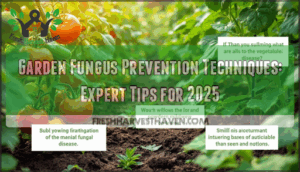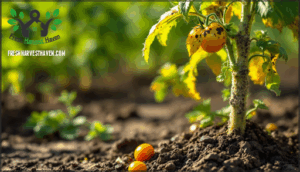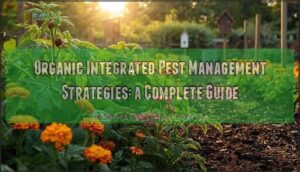This site is supported by our readers. We may earn a commission, at no cost to you, if you purchase through links.

The good news? Most fungal infections are preventable if you understand what triggers them and adjust a few key practices. Simple shifts in watering timing, plant spacing, and soil management can cut infection rates by 60% or more. Getting ahead of the problem means recognizing the conditions fungi love and denying them the foothold they need to damage your garden.
Table Of Contents
- Key Takeaways
- Causes of Garden Fungal Diseases
- Recognizing Early Signs of Fungal Infection
- Effective Garden Fungus Prevention Techniques
- Organic and Natural Fungus Control Methods
- Essential Garden Hygiene and Maintenance Tips
- Frequently Asked Questions (FAQs)
- What can I add to my soil to prevent fungus?
- How to get rid of fungal disease in the garden?
- What is a natural fungus killer for plants?
- Does vinegar kill garden fungus?
- Can beneficial fungi coexist with plant pathogens?
- How do seasonal weather changes affect prevention?
- Which fertilizers increase fungal infection risks most?
- Do container plants need different prevention strategies?
- How long should quarantine last for plants?
- Can rainwater spread fungal spores between plants?
- Conclusion
Key Takeaways
- Fungi cause up to 85% of plant diseases and thrive in conditions you can control—high humidity above 80%, temperatures between 68-86°F, and prolonged leaf wetness create the perfect setup for infection.
- Simple shifts in practice cut infection rates by 60% or more: water early morning to reduce leaf wetness, space plants 18-24 inches apart to improve airflow, use drip irrigation to keep foliage dry, and ensure proper soil drainage to starve root rot fungi.
- Early detection is your strongest defense—inspect plants twice weekly during humid months, remove infected tissue within 48 hours (cuts spread by 70%), and disinfect tools between cuts to stop spores from traveling between plants.
- Natural, low-cost solutions work effectively: baking soda spray reduces downy mildew by 60%, neem oil blocks spore formation, compost amendments boost beneficial microbes that suppress pathogens by 60-80%, and crop rotation every three years cuts soil-borne diseases by up to 90%.
Causes of Garden Fungal Diseases
Garden fungi don’t just show up by chance—they thrive under specific conditions you can learn to control. Understanding what triggers fungal diseases helps you prevent them before they take hold.
Let’s look at the key causes that set the stage for fungal problems in your garden.
Environmental Factors Favoring Fungal Growth
When humidity climbs above 80%, you’re practically inviting fungal pathogens to set up shop in your garden. Here’s what fuels their growth:
- Moisture Levels: High humidity and wet foliage create ideal conditions for spores to germinate and spread rapidly across your plants.
- Temperature Effects: Warm temperatures between 68-86°F accelerate fungal development, with most pathogens thriving in this range.
- Rainfall Influence: Frequent rainfall and overwatering keep leaf surfaces wet longer, directly increasing infection risk while poor soil drainage compounds the problem.
- Soil Microclimate: Dense plantings trap moisture and restrict light exposure, creating pockets of poor air circulation where fungi flourish. Sunlight exposure can negatively affect VAM fungi spore infectivity.
Managing these environmental factors gives you real control over preventing outbreaks.
Common Fungal Pathogens in Gardens
Your garden faces threats from five major fungal pathogen groups, with fungi causing up to 85% of all plant diseases. The most common culprits come from two families: Ascomycota and Basidiomycota. Understanding these enemies helps you spot trouble before it spreads.
Watch for these frequent offenders in your beds:
- Powdery Mildew and Downy Mildew: White or gray coatings on leaves, with over 72,000 documented cases worldwide
- Rust Diseases and Blight Pathogens: Orange pustules or rapid wilting that can destroy 10–30% of your harvest
- Root Rot and Black Spot: Underground decay and dark leaf lesions that weaken plants from multiple angles
Early identification gives you the upper hand against these persistent invaders. One significant threat to tomatoes is late blight disease, caused by Phytophthora infestans.
How Fungi Spread in The Garden
After spotting those common fungal culprits, it’s smart to understand how they move. Fungal spores use wind, water, and even insects as spore dispersal mechanisms, traveling from soil fungal reservoirs or infected plant matter to new hosts. Windborne spores can ride air currents for miles, while contaminated tools and hands quietly spread disease between beds.
Environmental spore release is triggered by moisture, and biotic dispersal agents like birds or bugs help fungi exploit spore dormancy strategies for survival.
Recognizing Early Signs of Fungal Infection
Catching fungal problems early can save your garden from serious damage. You’ll want to know what powdery mildew, rust, and blight look like on your plants, recognize trouble signs in roots and leaves, and understand why stressed plants get sick faster.
Let’s break down these warning signs so you can act before it’s too late.
Identifying Powdery Mildew, Rust, and Blight
Mastering powdery mildew identification starts with recognizing those telltale white, dusty patches on leaf surfaces—especially on new growth—where temperatures hover between 21–27°C. Rust identification requires checking leaf undersides for orange, yellow, or reddish pustules that appear powdery, often accompanied by chlorotic halos. Blight symptoms look dramatically different: dark brown lesions with concentric "bull’s-eye" rings signal early blight, while late blight creates water-soaked gray spots that can devastate crops within days.
- Powdery mildew: Uniform white coating on upper leaf surfaces, thriving in warm, dry conditions
- Rust: Wind-dispersed pustules on leaf undersides requiring moisture for germination
- Blight: Angular dark spots with rapid spread in cool, humid weather
- Microscopic features: Superficial hyphae versus intracellular haustoria distinguish these pathogens
Field observation shows correct visual diagnosis improves management efficiency by over 60%.
Symptoms in Roots, Stems, and Leaves
Fungal infections reveal themselves through a progression of symptoms that move from underground to canopy level. Root rot—caused by Phytophthora and Pythium species—transforms healthy white roots into brown or black masses that feel soft and break easily, often reducing water uptake by over 70% before you notice wilting above ground. Stem lesions appear as dark, water-soaked spots that can girdle the plant, while leaf spots create brown-to-tan patches with distinct borders that merge under humid conditions.
- Fine feeder roots decay first, silently compromising nutrient flow
- Stem rot develops white mycelium with black sclerotia near soil level
- Leaf blight produces straw-colored necrotic zones reducing photosynthesis by 60%
- Wilting patterns persist despite adequate soil moisture due to damaged xylem
- Growth abnormalities and premature leaf drop signal systemic stress responses
Recognizing these symptoms early gives you control over disease progression.
Plant Stress and Increased Susceptibility
When your plants face ongoing stress, their immune defenses drop sharply, inviting fungal takeover. Temperature extremes shift hormone balances—cold boosts resistance to some pathogens while heat suppresses it—but chronic stress always weakens overall protection.
Water stress pushes pathogen populations in plant vessels from 12% to over 31%, while nutrient deficiencies like low magnesium create sugar-rich tissues that fungi thrive on.
Meanwhile, adaptable pathogens evolve rapidly under these same environmental pressures, turning stressed conditions into their competitive advantage.
Effective Garden Fungus Prevention Techniques
Prevention isn’t about reacting to problems—it’s about building a garden where fungus struggles to survive. The key is creating conditions that favor your plants, not the pathogens.
Build a garden where fungus struggles to survive by controlling the conditions your plants need to thrive
Here’s how you can stay ahead of fungal threats with proven techniques that work.
Mastering Watering Practices
When should you water to stop fungal spores in their tracks? Early morning watering between 5:00 and 9:00 AM is your best defense—it cuts leaf wetness duration and reduces powdery mildew risk by up to 60% compared to evening watering.
Use drip irrigation or soil-level techniques to keep foliage dry, lowering fungal infections by over 70%. Aim for 1 to 1.5 inches of water weekly, including rainfall, and avoid overwatering—deep, infrequent watering beats shallow daily spritzes every time.
Proper soil moisture management and high water quality prevent the prolonged dampness fungi thrive on.
Improving Air Circulation and Spacing
Think of crowded plants like a packed subway car—nobody’s comfortable, and things get sticky fast. Poor air circulation traps humidity around leaves, creating prime conditions for fungal spores to settle and multiply. Spacing plants at least 30 cm apart cuts disease incidence by up to 70% compared to dense plantings.
To get the most out of air circulation, focus on these Combined Management Strategies:
- Ideal Plant Spacing – Maintain 18-24 inches between susceptible plants to lower microclimate humidity by 10-15%
- Ventilation Design Effects – Prune lower branches and thin crowded growth to improve air flow through the canopy
- Airflow Temperature Uniformity – Use vertical trellises and trellising to lift foliage, promoting even drying and reducing Spacing Disease Reduction failures
Maintaining Proper Soil Drainage
Soggy soil acts like a welcome mat for root rot and fungal invaders. When drainage fails, oxygen levels drop by over 60%, and those anaerobic conditions invite pathogens like Phytophthora straight to your plants’ roots.
Start by checking your soil composition—clay holds water far longer than sand, ramping up fungal activity by more than 50%. You can tackle soil compaction and poor water retention by mixing in organic amendments like compost (up to 30% by volume) or coarse sand.
Raised beds of 20–30 cm cut root-rot risk nearly in half, while drainage monitoring through regular testing keeps soil moisture in that sweet spot of 20–30%. Proper soil drainage isn’t just about avoiding overwatering—it’s about building soil structure that promotes long-term soil health.
Choosing Disease-Resistant Plant Varieties
Choosing disease-resistant varieties is like building a fortress—your first line of defense before fungi ever reach your garden. Over 60% of newly released tomato varieties now carry genetic resistance to major pathogens, slashing infection rates by up to 80%. When selecting plants, look for seed certification labels with resistance codes like VFN, which tell you exactly which fungal strains they’ll fend off.
Breeding advances through marker-assisted selection and wild relatives have expanded options across tomatoes, peppers, and berries. Regional adaptation matters too—varieties bred for high-humidity zones maintain 40% higher tolerance to blight.
Pair resistant varieties with integrated management practices to boost protection and cut fungicide use in half.
Practicing Crop Rotation
Resistant varieties give your plants built-in defenses, but crop rotation addresses pathogens already lurking in your soil. By shifting plant families every three years, you’ll cut soil-borne fungal diseases by up to 90% and boost yields by 10–25%.
Rotation intervals disrupt fungal life cycles, improve microbial diversity, and improve soil health naturally. Pair this with complementary practices like cover crops to fully realize disease suppression and build long-term soil suppressiveness for healthier crop health.
Organic and Natural Fungus Control Methods
When chemicals aren’t your style, nature offers proven alternatives that actually work. You can create effective fungal barriers using simple kitchen ingredients, soil amendments, and strategic garden practices.
Here’s how to protect your plants without reaching for synthetic treatments.
Homemade Fungicide Sprays (Baking Soda, Garlic, Neem Oil)
Your kitchen holds powerful fungal fighters that work surprisingly well when mixed correctly. Baking soda raises leaf surface pH to around 8–8.5, creating conditions that stop spores from germinating and can reduce downy mildew by up to 60%. Mix 1 tablespoon per gallon of water, adding a few drops of dish soap so it sticks to leaves. Garlic extract disrupts fungal cell membranes—crush one bulb per liter of water and let it steep overnight. Neem oil works differently, blocking spore formation at 0.5–2% dilution. You’ll get even better results combining these natural remedies, like pairing baking soda with neem oil for dual protection.
Why homemade fungicide sprays give you control:
- You’ll spend $5–$15 per hectare versus $80–$200 for synthetic fungicides
- Your crops stay residue-free and organic-certified
- Garlic extract achieves over 80% inhibition against common fungi like Fusarium
- Application safety improves since you’re avoiding harsh chemical exposure
- Spray combinations prevent resistance buildup that overcomes single-ingredient treatments
Beneficial Microorganisms and Compost Amendments
Beyond sprays, your soil’s living community provides long-term protection. Beneficial microorganisms like Trichoderma and Bacillus suppress pathogens through competition, cutting disease severity by 60–80%.
Compost amendments boost this defense—they boost microbial diversity by raising bacterial populations 32% on average while slashing harmful Fusarium counts by 40%. You’ll also see nutrient uptake jump 25–45% as these microbes break down organic matter into plant-available forms.
This sustainable management approach builds soil health that keeps working season after season, reducing your need for chemical fungicides by up to 40% while improving yields through natural disease suppression.
Using Mulch and Soil PH Management
Mulch and soil pH management work hand-in-hand to fortify your garden’s defenses. When you apply composted mulch at 2 inches deep, you’ll suppress nuisance fungi while maintaining stable pH levels.
Test your soil regularly—keeping pH between 6 and 7 maximizes both bacterial and fungal diversity, which naturally outcompetes pathogens. Avoid fresh wood mulches that can drop pH below 5.2, where harmful fungi thrive.
Choose pine bark or composted materials instead, and water thoroughly after application when moisture hits 50%. This approach lets beneficial microorganisms colonize quickly, blocking disease-causing fungi before they establish.
Essential Garden Hygiene and Maintenance Tips
Even the best prevention methods won’t work if your garden becomes a breeding ground for fungal spores. Good hygiene practices act as your first line of defense, stopping diseases before they take hold.
Let’s look at four essential maintenance habits that’ll keep your garden clean and your plants healthy.
Disinfecting Tools and Equipment
Your pruning shears can silently carry fungal spores from sick plants to healthy ones, turning a minor issue into a full-blown outbreak. Disinfecting tools and equipment is one of your most powerful defenses in fungal infection prevention. Alcohol wipes or a quick bleach soak breaks the transmission chain before pathogens spread. Here’s how to protect your garden:
- Choose your disinfectant wisely: Isopropyl alcohol (70%) works in 30 seconds without rinsing, while a 1:9 bleach solution needs 2–5 minutes but corrodes metal faster
- Disinfect between cuts when working with visibly infected plants and always after each pruning session to prevent contaminated tools from spreading disease
- Rinse tools after bleach to cut corrosion risk by 40% and extend tool life, or switch to Lysol for comparable pathogen control with minimal tool damage
- Consider bleach alternatives like boiling water (60 seconds kills 99% of bacteria) or trisodium phosphate for effective garden hygiene with less environmental impact
- Air-dry completely after disinfection to prevent cross-contamination and boost tool lifespan by roughly 25%, with proper storage maintaining sharpness longer
Removing Infected Plant Debris
Clearing away infected plant material cuts overwintering fungal spores by up to 80%, giving you real control over recurring infections. This sanitation step reduces your need for chemical fungicides by roughly 40% while stopping airborne spore dispersal by an estimated 70%.
Here’s your action plan for debris removal timing and proper disposal methods:
- Remove infected parts weekly during growing season – Fungal pathogens produce spores within 7–14 days under warm, humid conditions
- Cut 6 inches below visible damage – Use freshly disinfected pruners to prevent cross-contamination
- Seal debris in plastic bags for municipal disposal – Never compost diseased material, as pathogens survive in low-heat piles
- Clean up thoroughly in fall – Post-harvest debris removal reduces soil inoculum density by 50%, protecting next season’s plants
This garden hygiene practice forms the backbone of broader disease management and fungal disease prevention.
Regular Plant Inspection and Early Intervention
Catching problems early is your strongest advantage in fungal disease management. Routine plant health monitoring reduces fungal outbreak incidence by up to 60%, so inspection frequency matters—check your plants twice weekly during humid months to identify visible foliar lesions within seven days of infection.
Focus on leaf undersides, stem bases, and soil moisture levels where fungi first take hold. Recognizing early signs of fungal infection means spotting yellowing leaves, dark spots, or white powdery coatings before they spread. Timely treatment within 48 hours cuts infection spread by over 70%, turning crisis into minor setback.
Use diagnostic techniques like photographing suspicious growth and maintaining record keeping to track patterns across seasons. This risk assessment approach helps you improve garden strategies while identifying symptoms of fungus in roots, stems, and leaves before they compromise entire plants.
Safe Disposal of Infected Material
Proper disposal isn’t just cleanup—it’s your frontline defense in Garden Fungus Prevention. When you remove infected plant debris, double-bag it immediately to block fungal spores from drifting across your garden during transport. Home composting risks reinfection since most piles never hit the 60°C needed to kill pathogens.
Here’s your action plan:
- Burn where legal – Temperatures above 540°C eliminate 100% of active spores, though you’ll need to check local burning regulations first
- Bag and landfill – Seal contaminated material in double layers before transport protocols kick in, preventing 95% of airborne spread
- Disinfect everything – Clean contaminated tools with 10% bleach solution after each use, reducing pathogen transfer by 99%
- Document disposal – Waste audits help track biosecurity practices and prevent the 50% pathogen persistence rates seen in poorly managed sites
Frequently Asked Questions (FAQs)
What can I add to my soil to prevent fungus?
The secret to healthy soil isn’t just what you remove—it’s what you add. Beneficial microbes like Trichoderma and compost amendments introduce organisms that suppress fungal pathogens by up to 80%.
Add biochar application and mineral amendments like sulfur to adjust soil pH between 0–5, where fungi struggle. These improve soil drainage and boost disease suppression naturally.
How to get rid of fungal disease in the garden?
Fungal disease management demands swift action and integrated pest management. Remove infected tissue immediately, apply natural fungus killer for plants like neem oil or copper-based treatments, and space plants properly to boost airflow.
Treating fungus naturally works best with improved drainage and homemade fungicide sprays for long-term solutions.
What is a natural fungus killer for plants?
Several natural options effectively control plant fungi. Baking soda spray works by creating an alkaline surface that stops fungal growth—mix one teaspoon per quart of water with a dash of liquid soap for better adhesion.
Neem oil disrupts spore development at 1-2% concentrations, while garlic extracts deliver antifungal sulfur compounds that inhibit common pathogens like Botrytis and Fusarium.
Does vinegar kill garden fungus?
Can vinegar truly eliminate fungi from your garden? Yes, vinegar works as a natural fungicide because its acetic acid disrupts fungal cell function and lowers soil pH.
At 10% concentration, vinegar achieves over 80% efficacy against common fungi, but higher concentrations risk plant tissue burns and soil microorganism damage.
Can beneficial fungi coexist with plant pathogens?
Yes, beneficial fungi and fungal pathogens can coexist in your soil ecosystem. Healthy soil fosters diverse beneficial microorganisms that outcompete harmful fungi through fungal competition, antibiosis mechanisms, and induced resistance—achieving natural disease suppression that protects soil health without eliminating pathogens entirely.
How do seasonal weather changes affect prevention?
Weather patterns throughout the year reshape your fungal prevention strategy. Spring’s warmth and moisture boost spore activity—high humidity can increase outbreaks by 36%. Summer heat above 26°C reduces powdery mildew by 50%, but stressed plants remain vulnerable. Fall’s dampness creates ideal fungal conditions, while winter’s cold slows most pathogens, offering recovery time.
Which fertilizers increase fungal infection risks most?
Nitrogen-heavy fertilizers—especially ammonium and NPK blends—can spike fungal infection risks by up to 80%.
They weaken plant defenses, increase tissue moisture, and create nutrient-rich conditions that pathogenic fungi thrive on.
Do container plants need different prevention strategies?
Container plants need different prevention strategies because root confinement and limited drainage create higher fungal risks.
Focus on proper drainage holes, well-draining potting media, morning watering at the base, and adequate spacing for airflow optimization.
How long should quarantine last for plants?
Quarantine new plants for 2–4 weeks minimum, though high-risk varieties—tropical plants, ferns, or those from large retailers—benefit from 6–8 weeks. Check weekly for wilting, discoloration, or unusual spots.
Pathogen incubation periods and your plant’s origin greatly influence quarantine length, making longer isolation worthwhile to prevent fungal diseases from spreading to established garden plants.
Can rainwater spread fungal spores between plants?
Yes, rainwater spreads fungal spores through splash dispersal. When raindrops impact infected plants, they propel spores several meters away. Rain intensity and larger droplets increase dispersal distance considerably.
High moisture from rain accelerates spore germination and infection. This mechanism drives rapid disease outbreaks across gardens during wet periods.
Conclusion
Fungi don’t discriminate between neglected gardens and well-tended ones—they thrive wherever moisture lingers and air stagnates. Yet prevention flips this equation entirely.
By mastering garden fungus prevention techniques through strategic watering, spacing, and soil management, you transform your garden from a fungal invitation into a fortress. The work isn’t constant; it’s deliberate.
Start with one practice, watch results compound, and you’ll never return to reactive rescue missions. Prevention isn’t just easier—it’s the difference between thriving plants and lost harvests.
- https://www.thrivelot.com/resources/5-crop-rotation-tips-to-prevent-plant-diseases
- https://www.sare.org/publications/crop-rotation-on-organic-farms/physical-and-biological-processes-in-crop-production/managing-plant-diseases-with-crop-rotation/
- https://farmonaut.com/blogs/common-fungal-diseases-5-innovative-strategies-2025
- https://www.marketreportanalytics.com/reports/seed-treatment-biological-fungicide-122215
- https://pmc.ncbi.nlm.nih.gov/articles/PMC117440/









